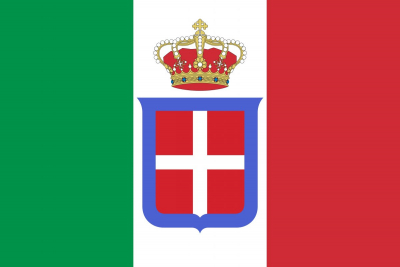The Lateran Treaty (Italian: Patti Lateranensi; Latin: Pacta Lateranensia) was one component of the Lateran Pacts of 1929, agreements between the Kingdom of Italy under King Victor Emmanuel III of Italy and the Holy See under Pope Pius XI to settle the long-standing Roman Question. The treaty and associated pacts were named after the Lateran Palace where they were signed on 11 February 1929, and the Italian parliament ratified them on 7 June 1929. The treaty recognized Vatican City as an independent state under the sovereignty of the Holy See. The Italian government also agreed to give the Roman Catholic Church financial compensation for the loss of the Papal States. In 1948, the Lateran Treaty was recognized in the Constitution of Italy as regulating the relations between the state and the Catholic Church.
The Kingdom of Italy (Italian: Regno d'Italia) was a state that existed from 1861—when King Victor Emmanuel II of Sardinia was proclaimed King of Italy—until 1946, when civil discontent led an institutional referendum to abandon the monarchy and form the modern Italian Republic. The state was founded as a result of the Risorgimento under the influence of the Savoy-led Kingdom of Sardinia, which can be considered its legal predecessor state.
Italy declared war on Austria in alliance with Prussia in 1866 and received the region of Veneto following their victory. Italian troops entered Rome in 1870, thereby ending more than one thousand years of Papal temporal power. Italy entered into a Triple Alliance with the German Empire and the Austro-Hungarian Empire in 1882, following strong disagreements with France about the respective colonial expansions. However, even if relations with Berlin became very friendly, the alliance with Vienna remained purely formal as the Italians were keen to acquire Trentino and Trieste, corners of Austria-Hungary populated by Italians. So during World War I, Italy accepted the British invitation to join the Allied Powers, as the western powers promised territorial compensation (at the expense of Austria-Hungary) for participation that was more generous than Vienna's offer in exchange for Italian neutrality. Victory in the war gave Italy a permanent seat in the Council of the League of Nations.
"Fascist Italy" is the era of National Fascist Party government from 1922 to 1943 with Benito Mussolini as head of government. The fascists imposed totalitarian rule and crushed the political and intellectual opposition, while promoting economic modernization, traditional social values and a rapprochement with the Roman Catholic Church. According to Payne (1996), "[the] Fascist government passed through several relatively distinct phases". The first phase (1923–1925) was nominally a continuation of the parliamentary system, albeit with a "legally-organized executive dictatorship". Then came the second phase, "the construction of the Fascist dictatorship proper, from 1925 to 1929". The third phase, with less activism, was 1929 to 1934. The fourth phase, 1935–1940, was characterized by an aggressive foreign policy: war against Ethiopia, launched from Italian Eritrea and Italian Somaliland, which resulted in its annexation; confrontations with the League of Nations, leading to sanctions; growing economic autarky; and the signing of the Pact of Steel. The war itself (1940–1943) was the fifth phase with its disasters and defeats, while the rump Salò Government under German control was the final stage (1943–1945).Fascist Italy was a leading member of the Axis powers in World War II. By 1943, the German-Italian defeat on multiple fronts and the subsequent Allied landings in Sicily led to the fall of the Fascist regime, and Mussolini was placed under arrest by order of the King Victor Emmanuel III. The new government signed an armistice with the Allies on September 1943. German forces occupied northern and central Italy, setting up the Italian Social Republic, a collaborationist puppet state still led by Mussolini and his Fascist loyalists. As a consequence, the country descended into civil war, with the Italian Co-belligerent Army and the resistance movement contending with the Social Republic's forces and its German allies. Shortly after the war and the liberation of the country, civil discontent led to the institutional referendum on whether Italy would remain a monarchy or become a republic. Italians decided to abandon the monarchy and form the Italian Republic, the present-day Italian state.

1929Feb, 11
Kingdom of Italy and the Vatican sign the Lateran Treaty.
Choose Another Date
Events on 1929
- 31Jan
Leon Trotsky
The Soviet Union exiles Leon Trotsky. - 26Feb
Grand Teton National Park
President Calvin Coolidge signs an executive order establishing the 96,000 acre Grand Teton National Park in Wyoming. - 8Apr
Bhagat Singh
Indian independence movement: At the Delhi Central Assembly, Bhagat Singh and Batukeshwar Dutt throw handouts and bombs to court arrest. - 21Jun
Cristero War
An agreement brokered by U.S. Ambassador Dwight Whitney Morrow ends the Cristero War in Mexico. - 23Aug
1929 Palestine riots
Hebron Massacre during the 1929 Palestine riots: Arab attack on the Jewish community in Hebron in the British Mandate of Palestine, continuing until the next day, resulted in the death of 65-68 Jews and the remaining Jews being forced to leave the city.

 English
English  español
español  français
français  português
português  русский
русский  العربية
العربية  简体中文
简体中文 